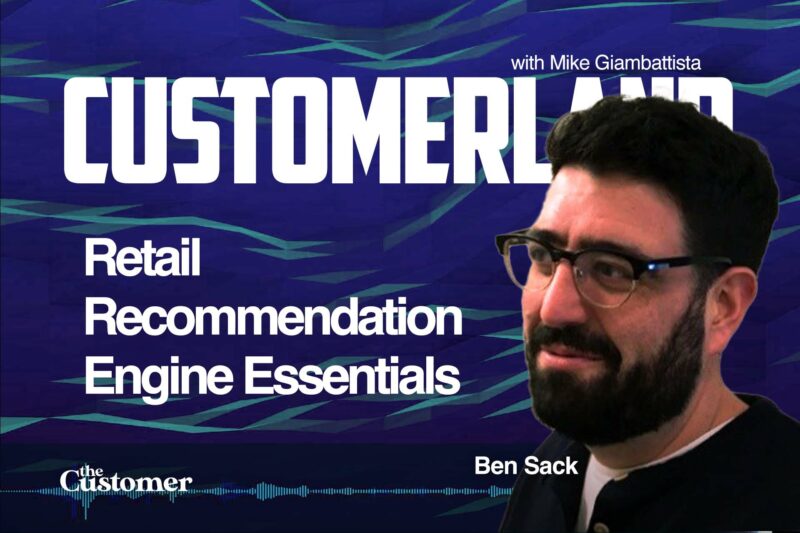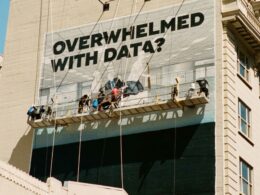What is a product discovery engine anyway? Think about that for a minute. Is it cross sells and upsells? Now, think about a product discovery engine that’s based on AI image discovery that wraps itself around the user experience on your site. That’s one of the things that Syte does. Syte is one of these great technologies that I was introduced to at NRF and today I talked to Ben Sack, who is Syte’s Regional VP. It’s a great conversation – really enlightening. If you’re an e-commerce provider, in any sense, you’re going to enjoy this.
Also, a special nod to our sponsor, Allant Group.
Ben Sack:
Product discovery is generally what we do, but we of course have a really unique and I think special approach to how we do it because, you know, especially now in 2023 after, you know, we all survived, you know, what we did in the past few years, you know, we’ve seen a real trend towards, you know, the online shopping and, you know, the, you know, the way people go about finding the products that they love there. Now one of the great challenges when, you know, trying to engage someone online is, you know, helping them find that thing that’s inspiring them, you know, quick and efficiently and, you know, in a, a way that makes them want to come back. And what we do is we actually take the way humans naturally want to shop and bring it into that digital experience. And that’s with their eyes through the visual cues in, you know, the shoppers, catalogs and websites, all those incredible, you know, images and things that they curate for their experience, you know, site with its AI capabilities does a lot of interesting things like with that, you know, essentially becoming a, a whole wrapper around the experience making all the imagery shoppable and letting shoppers do a lot of interesting things with those images on the website.
Mike Giambattista:
Could you, without taking us too deep into the weeds, tell us what that might look like for a user, you know, how, how do, how would they experience site?
Ben Sack:
Yeah, definitely. There’s a lot of ways that they can encounter site, you know themselves like, you know, through their own interaction, but also in ways in, they don’t even know that site is impacting their journey, you know, so on the front end, you know, you know, the, the immediate level in which site can touch that path is just allowing someone to bring an image to a website and search via image. So, you know, if someone’s on an Instagram feed or you know, Facebook, they see an influencer that they like and they wanna grab that look. They don’t need to, you know, apply their own, you know, logic and try to think how to describe that thing on the website, you know, and go on some, you know, potentially challenging journey. They just literally need to take that photo to the image and pull all the different products out of that image and, and find them all in a few clicks.
Wow. Yeah, it’s really powerful. But honestly, that’s, you know, the tip of the iceberg, you know, from there, you know, we can add site content to any image on a website, you know, homepage or anywhere else on the journey and make all the items in that image shopable. We developed some interesting content with one of our partners, fashion Nova. They came to us with unique challenge. They’re in fast fashion, and so they, they’ve got a lot of great inventory, but you know, they move through it pretty quickly and they, you know had a problem with things going out of stock. And so they came to us and we worked together to think how we could leverage sites AI to address that. And what we did is anytime someone engages with something that’s out of stock on their website, instead of just being presented with, you know, the opportunity to give an email and come back. In addition, we’re also presenting them with all the visually similar items that are currently available in their catalog in that size right now. So we’re eliminating a very big dead end that they had on their website. So that’s, yeah, go ahead.
Mike Giambattista:
No, I, I’m just thinking out loud here, that that’s depending on the size of the catalog, that could be a pretty giant undertaking to, to index all of that visual information for a, for an entire catalog. That, that seems like, well, I’m sure you just don’t have rooms and rooms full of people doing data entry. There’s probably a better way to do that.
Ben Sack:
Yeah.
Mike Giambattista:
Does that work?
Ben Sack:
You’re absolutely right. I we’re, I know we’re only audio, but I’m smiling right now cuz <laugh>, you know, that’s the, that’s the power of site is that we’ve got this incredible machine behind what we do that actually makes that indexing process, you know, on our, for the customers, seamless, you know, we, we have people sending us their catalog, you know, in real time. So we can manage those, you know, in that scenario, manage stock levels. But generally the idea is that we, we’ve got this, you know, really powerful AI with, you know, different models that service specifically fashion, home decor and jewelry. And all we require is a feed, you know, from our vendors. And then, you know, with that we can do all the cool things that we do. Now, the power of it is that, you know, we, of course we do have humans working in our business and some of them actually a good chunk of our companies actually on what we call the data team, and they spend their time training our models on the front end for, you know, trends and fashion and, and other areas to make sure that, you know, the recommendations and the similarity we’re putting out there are in line with, you know, the industry today.
So there is of course a lot of sophistication and expertise that goes into it, but I think that’s what makes, you know, you know, the best tools out there, the ones that on the backend are, you know, sophisticated and nuanced, but on the front end are quite simple and elegant.
A Message from our Sponsor

Allant is an audience orchestration engine leveraging data analytics, experience management, and MarTech integration to power the solutions behind successful customer journeys. Everything they do is based on the proven principle that customers want a more relevant, less intrusive and privacy centered relationship with brands, and they want to interact with brands on their terms, with their needs in mind, in the channels they choose a lot gives some of the largest and best known brands in their category a competitive advantage to deliver better lifecycle experiences to individualize, nurture, and energize the relationship between the brand and their customers. Check them out at AllantGroup.com, that’s A-L-L-A-N-T Group.com
Mike Giambattista:
Right? Right. And it also occurs to me that there’s probably, and I don’t know if site does this, but there’s probably a huge opportunity to derive insights from the front end on how people are interacting with all of that you know, freshly presented imagery and you know, what’s working, what’s not, and you know, linger times and, you know, all of those subtle and kind of secondary cues is probably a wealth of information out there. Does Site one one, I guess is, does site collect that? And then if so, what does site do with that? And, you know, how is that how does that benefit the retailer?
Ben Sack:
It’s a, that’s a another great question. So actually I want to answer that and give a little bit more context because, you know, we do, you know, just first of all, you know, site as a business is a data driven company. That’s the core of what we do as process visual data. So we, we do actually provide a lot of interesting insights for our customers based off of, you know, on the front end, the interactions that we see with site content, the types of images that they’re looking at, and, you know, the, the journey that that takes them on through the website. One of the things that we actually pride ourselves on is the iteration and optimization process that we go through with our customers to, you know, constantly grow the value that we’re driving for them. But one thing we actually haven’t discussed yet is the backend capabilities.
I alluded this, you know, at the front when I said, you know, we can touch customers’ lives in, you know, ways that they’re not even aware of. One additional thing that we do for retailers is actually take their catalog can run it through our AI and produce AI-based attribution on the visual qualities we see in the image. We even have the ability to create, you know thematic tags or rule-based attributes to apply like seasonality and, you know style and occasion and, you know, these types of things to the, the products as well. And you know, with that, we do a lot, it’s not just about, you know, enhancing a search or creating new filtering, but you know, we’re actually doing, to your question, some interesting analytics based off of the tagging and the way products are moving, you know, v-neck shirts that are black and crew neck or, or short sleeve, excuse me you know, are moving a lot quicker now and we project that over the next six months they’re gonna continue the trend in this way. So it’s actually really fascinating some of the things that we’re doing.
Mike Giambattista:
Again this cuz we’re in danger of going too deep in the weeds on this, but, you know with that kind of data flowing out of site, does it go into a site dashboard or do you pipe that into say the, the retailer’s c D P and then they kind of give it a full analysis? Or how does that work? I mean, how do you, how do you manage that?
Ben Sack:
Yeah. you know, it’s, it, the short answer is both. Okay. That’s because it’s not a one size fits all world right. Site of course has its own, you know, dashboards, you know, and when, you know, we work with, you know, some of the great partners like we do, you know, of course we’ll provide them with that deep look at the, the data from our side. But, you know, we work with some really incredible brands, you know, the VF Corp fashion Nova, Chicos, you know, Larado, you know Cignet. And of course they’ve got very sophisticated, you know data teams on their end and Will, everything that we generate will, we’ll, we’ll feed into their systems as well and, you know, they can do their own modeling and everything else.
Mike Giambattista:
Interesting. well I think I’m gonna try leave the, the, the specifics about the platform alone for a moment. Sure. we’ll probably come back to some of this, but I wanted to just kind of zoom out and get your take on what you’re saying because you interact with, with a lot of different retailers, different, different levels of sophistication, different kind of niches out there. But I think, I think just to bring some interest into this conversation for people who might not, you know, know or care what site does Yeah. What they probably would care about is your perspective on the industry, what you see out there that could impact their businesses and their lives and their businesses. So I’ll just put it to you, you know, on a, on a kind of macro basis the, the hurdles you, you see that not only site is solving for, but that retailers are just now dealing with. If you see things on the horizon that you, you think might present challenges, you know, give us your perspective on, on retail as a whole as you see it.
Ben Sack:
Wow. Big question. Yeah,
Mike Giambattista:
I know, I know.
Ben Sack:
Okay. so maybe, maybe we’ll start big and I’ll drill down. Because I mean, first of all, you’re right. I, I feel really fortunate I get to talk to a lot of, you know, great retailers every day. So yeah, I, I hear a lot of interesting stories from the market and, you know, I think generally, you know, the, the common trend that I see across the board is, you know, 2023 is a year of you know efficiency, a year of, you know, optimization. You know, people really looking to see where they can get the most, you know, out of what they have. Because, you know, I I, I think the end of the year for a lot of people prove to be a little bit challenging. So they’re looking to see, you know, what 23 brings. Now when we think about that, you know, from the shopper perspective and what it means for the brands as well, I think that, you know, the individual is going through a little bit of a similar process probably but on a micro level.
And so for them, I think they’re gonna be really picky about, you know, where they shop and, you know, the types of things that they’re looking for. And so for retailers, it’s gonna make it even more important to try and capture those people when they come to their website, you know create that most effective path to drive them towards that thing that’s inspiring them because, you know, making sure that they’re converting everyone that comes through is gonna become that much more critical. So it’s actually those types of conversations that are driving a lot of the people I’m talking to, to look at site now because they know that they need to essentially have an insurance policy for that, you know, marketing spend that they have to make sure that they’re maximizing on everything they bring through the door. Right.
Mike Giambattista:
You know, just anecdotally, I was in conversation, I guess this was last week now with an analyst group and they’ve, you know, they give deep coverage to all things retail technology and from their research they see that the areas of biggest spend by the category leaders are where they can bring efficiencies into, into existing operations. And and if it’s in store, that’s a huge area of investment. If it’s online, that’s a huge area of investment. I mean, everybody at the show was talking about retail media networks, and that’s its own thing right now that, you know, people are still trying to figure out. But, but store operations online and and brick and mortar where they can find ways of managing inventory to improve efficiencies there, but also to the existing prospect relationship, either more fast share or at least attention are gonna be huge areas investment. It seems like you’re kind of addressing a handful of those.
Ben Sack:
Yeah. actually I see retailers coming to site for a lot of different reasons. You know, you’re absolutely correct. I think it, you know, I mentioned it before, it’s not a one size fits all world. The challenges that people are looking at in their specific markets or verticals are unique to them. But you know, you know, we’ve spent a lot of time talking about the front end experience. You, you mentioned even the in-store, like where people are looking for efficiency there and to optimize, you know, when it comes to inventory management, you know, people are leveraging our deep tags to help them understand that people are leveraging site capabilities in store with their associates to help find products faster for the customers or power customer facing apps, you know, and localizing that app, localizing the site content on that app to reflect only things in the store or in the region, you know?
Mike Giambattista:
Oh, very cool.
Ben Sack:
Yeah, there’s a lot of ways to manipulate site to really fit the brand and the use case. So I mean, I think you’re spot on, like even in store or online, like we see people looking at site for a lot of different things.
Mike Giambattista:
Yeah. I, I, I wish I, I’m not the one who derived those insights, I was simply listening to some friends talk, but it’s, but these are smart people and they people tend to listen when they, when they speak hang out with just curious also. What’s that?
Ben Sack:
I said you hang out with good people, Mike. Yeah,
Mike Giambattista:
I try to, yeah. <Laugh>, it’s a compensation issue and we’re still working out, but <laugh> so are there any particular technology ecosystems where site plays better? Are there any technology sweet spots, and I guess what I mean by that are, you know, I’m sure you’ve worked out, you know, lots and lots of APIs to, to interact with lots and lots of different systems. But, you know, would you say that for instance, you work better with SAP powered houses? Or would you, you know, Microsoft powered houses or anything like that?
Ben Sack:
I wouldn’t say that <laugh>.
Mike Giambattista:
Okay. <laugh>.
Ben Sack:
And I would say you know, the reality about sight, and this is, you know, another part of the beauty is, I mean, we’re genuinely platform agnostic. Like we, we do have native integrations built out with, you know, a lot of those folks you just mentioned. But, you know, at its core, like you can deploy site via a p i or JavaScript. I mean, it doesn’t, it’s really built to meet the needs of the business.












